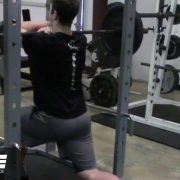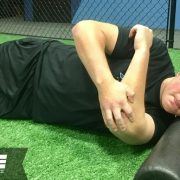How to Use the Weight Room for Baseball Pitching Mechanical Issues
I truly believe that for those athletes that can do certain basic things properly the sky is the limit. However, the reality is that the underlying foundation that enables pitchers to do these “basic things” is great strength and mobility (in other words a good movement strategy).
Let me first start by saying this: there is no pitching coach on the planet that can get a pitcher into a desired position if the athlete does not physically have the strength or mobility to get into that position. Period.
Case in point, Cleveland Indians pitcher Robbie Aviles came to me a couple of years ago after a long season, presenting with a lack of Internal Rotation (IR) in his lead leg and a limited ability to engage his core. This side-by-side video demonstrates what his squat looked like at his assessment (left) and one hour later, after some intensive training focusing on strength and mobility.
(Robbie Aviles – Before and After)
Which pitcher (before or after) do you think will be capable of throwing more gas and for a longer period of time?
After cleaning up Robbie’s hip IR, his anterior tilt and making him aware of what great core control is all about.
It’s really all about being more mobile and stronger and being able to physically get into positions you need to get into to be successful on the mound.
In keeping with our concept of the Closed Loop, where your pitching coach and strength coach work in sync to achieve a result, I thought it would be appropriate to give some insight into how we help fix some of the issues that we observe on the mound from a strength and mobility standpoint (i.e. the weight room).
Maintaining a Healthy, Clean Arm Action
The words “stress free and clean” are the key words here. The bottom line is clearing pathways from a mobility standpoint, or creating stability by increasing strength, allows the body to take the path of least resistance.
This in turn takes stress off the muscles and joints that are trying to do the job all by themselves.
A great example is strengthening the core to give the arm a more stable base of support to throw from.
Here’s a great exercise to strengthen the core while the arm goes into the overhead position.
Shoulder to Hip Separation
We need thoracic spine (upper back) rotation to achieve a great pre-stretch in the hips/core in order to help create good hip-shoulder separation.
Successfully creating a great pre-stretch in the upper half while transferring force up the chain and into the arm, requires great core strength as well.
This core strength also gives us the stiffness needed to “hold” the upper body in place when the lower half starts to rotate, helping to create valuable torque when the upper body finally does start to unwind.
Once again, you can’t coach bodies into a position they’re not strong enough to get into or maintain.
Balance and Alignment
Achieving proper weight exchange at the appropriate time requires a strong lower half to be able to apply this strength in a specific manner.
Teaching this is possible, but only if the back leg and glutes are strong enough to maintain body weight and force into the ground on one leg while moving down an incline. Here’s a great one to get it done:
Another way to effectively transfer bodyweight, while maintaining great balance, is to have great core strength.
This first exercise is different than the one mentioned in #1 above due to the fact that it uses the core to dynamically transfer body weight and power from the lower half to the upper half in the frontal and transverse planes.
Timing and Rhythm
For pitchers, timing and rhythm is everything. If your throwing arm isn’t where it’s supposed to be when your front foot lands, you’re working against your body and your arm is playing catch-up.
This final point is a great example of how a mechanical problem in one area (in this case late arm action), could be caused by a mobility issue in a completely different side and/or part of the body.
For example, a lead hip that closes off early due to a lack of stability (strength) and/or internal rotation (mobility) could cause the arm to fly open early, helping to contribute to that late arm action as well as creating a “bang” on the anterior shoulder.
Here are two exercises that work on both strength and mobility:
Too often pitchers fail, not because they don’t train hard enough on the mound, but because they can’t physically do what is being asked of them.
I want to close by saying that a great throwing program MUST include input and development from both sides of the net. Only then can you ensure that you are giving it your all.
Remember:
You absolutely need both.
See ya’ in the gym…
Nunzio Signore
Latest posts by Nunzio Signore (see all)
- 4 Ways to Improve Your Command and Control in the Weight Room - November 13, 2018
- How to Use the Weight Room for Baseball Pitching Mechanical Issues - August 7, 2018
- Combining Strength Training And Throwing Programs For Baseball Pitchers - March 27, 2018











Leave a Reply
Want to join the discussion?Feel free to contribute!